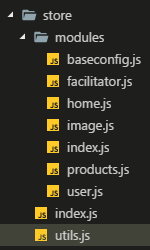對某專案中Vuex用法的分析
阿新 • • 發佈:2018-11-05
上週五剛釋出一個線上版本,趁著新的需求和bug還沒到來,決定分析一下正在維護的一個使用Vue 2.0 開發的後臺管理系統中Vuex部分程式碼。這部分程式碼不是我寫的,加上我一直在“使用”現成的而不是“搭建”專案,所以這是一個很好的提升。
使用npm安裝vuex,在src檔案下建立store資料夾,如下:

各檔案/資料夾用途:
/store -- Vuex程式碼資料夾
/store/index.js -- 建立store例項,匯出
/store/utils.js -- 各種工具,該專案utils.js檔案建立了一個store建構函式,匯出
/store/modules/ -- store中子模組
/store/modules/image.js -- j將modules中的各個檔案匯出的子模組彙總到一起,匯出
/store/modules/image.js -- store中image子模組,與該專案中“圖片庫管理”模組對應
/store/index.js建立store例項匯出後,在專案的入口檔案main.js(或index.js)中引入,並注入到根節點中,這樣一來所有元件都能獲取store中的資料。另外,如果想在元件中使用mapMutations等輔助函式,需在該元件中手動從vuex中引入:
import { mapMutations, mapActions } from 'vuex'
/store/index.js:
import Vue from 'vue'; import Vuex from'vuex'; import modules from './modules'; // 匯入各個子模組 Vue.use(Vuex); const store = new Vuex.Store({ // 建立store例項 modules: { ...modules, }, }); export default store; // 匯出store例項,在入口檔案中注入根節點
/store/modules/index.js:
import home from './home'; // 匯入各個子模組 import * as products from './products'; import* as user from './user'; import * as image from './image'; import * as facilitator from './facilitator'; import * as baseconfig from './baseconfig'; /*<狀態注入>*/ export default { // 將各個子模組彙總成一個物件,也可以直接在store/index.js中完成 /*<模組注入>*/ ...products, ...facilitator, ...baseconfig, ...user, ...image, home, };
/store/modules/image.js:
import Store from "../utils"; // 引入store模組建構函式 const imageCategory = Store("image-category", {}, null); // 利用建構函式,每一個介面都生成一個store模組 const image = Store("image", {}, null); const imageUpload = Store("image/upload",{},null) const skuImgs = Store("sku/imgs",{},null) export { // 匯出各個store模組 imageCategory, image, imageUpload, skuImgs }
/store/utils.js:
// 生成一個公共的store import fetch from '@/fetch'; import _ from '../utils/lodash'; import tools from '../utils/utils'; import config from '@/config/config'; /** * * @param {*} action 請求地址 * @param {*} obj 引數物件,傳入的引數可以替換預設store * @param {*} apiName 配合後端微服務 不同介面字首 */ // const Store = (action, obj = {}, apiName = '') => { // 建立一個建構函式,用來生成store模組 let api = `${config.getApi(apiName)}${action}`; const store = { namespaced: true, // 使用名稱空間 state: { // 非同步loading控制 loading: false, // 資料列表 list: [], // 資料物件 data: {}, // 資料條數 count: 0, url: action, }, getters: { // 獲取狀態資料 data(state, getters) { return state; }, }, mutations: { // 突變資料 setOne(state, res) { if (res.code != 200) { } else { state.data = res.data; } state.loading = false; }, // 突變列表 setList(state, res) { if (res.code != 200) { } else { state.list = res.data.docs; state.count = res.data.count; } state.loading = false; }, // 開啟loading changeLoading(state, loading) { state.loading = loading; }, }, actions: { // 獲取單條資料 getByParams({ state, commit }, params = {}) { commit('changeLoading', true); return fetch .get(api, params) .then(res => { commit('setOne', res); return res; }) .finally(one => { commit('changeLoading', false); }); }, // 獲取單條資料 getById({ state, commit }, id) { commit('changeLoading', true); return fetch .get(`${api}/${id}`, {}) .then(res => { commit('setOne', res); return res; }) .finally(one => { commit('changeLoading', false); }); }, // 獲取列表資料 getList({ state, commit }, params = {}) { commit('changeLoading', true); if (!params.pageSize) { Object.assign(params, { pageSize: 20 }); } if (!params.pageNo) { Object.assign(params, { pageNo: 1 }); } return fetch .get(api, params) .then(res => { commit('setList', res); return res; }) .finally(one => { // debugger commit('changeLoading', false); }); }, // 新增資料 post({ state, commit }, params = {}) { commit('changeLoading', true); return fetch .post(api, params) .then(res => { return res; }) .finally(one => { commit('changeLoading', false); }); }, // 修改資料 put({ state, commit }, params = {}) { commit('changeLoading', true); return fetch .put(api, params) .then(res => { return res; }) .finally(one => { commit('changeLoading', false); }); }, // 刪除資料 delete({ state, commit }, id) { commit('changeLoading', true); return fetch .delete(`${api}/${id}`, {}) .then(res => { return res; }) .finally(one => { commit('changeLoading', false); }); }, // 刪除資料query deleteByQuery({ state, commit }, params) { commit('changeLoading', true); let query = tools.queryString(params); return fetch .delete(`${api}?${query}`, {}) .then(res => { return res; }) .finally(one => { commit('changeLoading', false); }); }, // 批量刪除資料 deleteBatch({ state, commit }, ids) { commit('changeLoading', true); return fetch .delete(api, ids) .then(res => { return res; }) .finally(one => { commit('changeLoading', false); }); }, }, }; const newStore = _.merge({}, store, obj); return newStore; }; export default Store;
在入口檔案中Vue例項的根節點注入store後,就可以在元件中獲取Vuex中的各種資料了,也可以使用actions呼叫介面進行各種操作。
